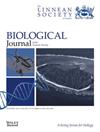更新世气候振荡影响了安第斯蚱蜢物种群中地理分布广泛且受限的遗传系的出现
IF 1.5
3区 生物学
Q3 EVOLUTIONARY BIOLOGY
引用次数: 0
摘要
蚱蜢 Trimerotropis pallidipennis 种群分布在北美洲到南美洲的干旱和半干旱环境中,沿安第斯山脉可到达高海拔地区。目前,南美洲有四个有效的 Trimerotropis 物种。然而,一些物种被发现由多个遗传系组成。在此,我们根据线粒体 COI 基因序列、4048 个单核苷酸多态性和生态位模型,描述了南美洲 Trimerotropis 物种群的遗传结构、世系分化和环境要求。分析结果表明至少存在五个世系:两个世系的地理分布有限,三个世系的地理分布非常广泛。研究结果证明,冰川周期不仅促进了避难区的存在,而且还隔离了安第斯山脉南部东西两侧广泛分布的品系,这有可能是能够耐受更温和生境的 Trimerotropis sp.品系出现的原因。我们的研究结果为更新世气候变化对南美洲蚱蜢物种群多样化历史的影响提供了证据。本文章由计算机程序翻译,如有差异,请以英文原文为准。
Pleistocene climatic oscillations influenced the emergence of geographically widespread and restricted genetic lineages in an Andean grasshopper species group
The grasshopper Trimerotropis pallidipennis species complex is distributed across arid and semi-arid environments from North to South America, reaching high altitudes along the Andes Mountain range. Currently, there are four valid species of Trimerotropis in South America. However, some species were found to comprise several genetic lineages. Here, we describe the genetic structure, lineage diversification, and environmental requirements within the Trimerotropis species complex in South America based on sequences from the mitochondrial COI gene, 4048 single nucleotide polymorphisms, and ecological niche modelling. The analyses revealed the existence of at least five lineages: two with a restricted geographical distribution and three with a very wide one. The results provide evidence that glacial cycles promoted not only the presence of refuge areas but also the isolation of widely distributed lineages on the eastern and western sides of the southern Andes, potentially driving the emergence of the Trimerotropis sp. lineage, which can tolerate more temperate habitats. Our results provide evidence for the effects of Pleistocene climatic changes on the diversification history of a South American grasshopper species complex.
求助全文
通过发布文献求助,成功后即可免费获取论文全文。
去求助
来源期刊
CiteScore
4.30
自引率
10.50%
发文量
140
审稿时长
3-6 weeks
期刊介绍:
The Biological Journal of the Linnean Society is a direct descendant of the oldest biological journal in the world, which published the epoch-making papers on evolution by Darwin and Wallace. The Journal specializes in evolution in the broadest sense and covers all taxonomic groups in all five kingdoms. It covers all the methods used to study evolution, whether whole-organism or molecular, practical or theoretical.d.

 求助内容:
求助内容: 应助结果提醒方式:
应助结果提醒方式:


